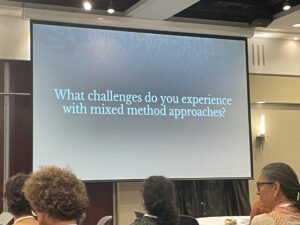Beyond the Toolbox: The Challenge of Mastering Mixed Methods in SES
Written by Jonathan Vivas and edited by Kirill Orach Photos by Jonathan Vivas

In our journey to delve deeper into social-ecological systems (SES), We’ve realized that having a diverse toolbox is essential. However, the real challenge goes beyond just identifying the right tools—it’s about understanding how they’ve been applied and blended in practical settings.
Bridging Ways of Knowing: The Promise of Mixed Methods
We recently participated in a mini-workshop at PECS-3 that brought this truth into sharp focus. The session led by Alta de Vos, Maja Schlüter, and Michele-Lee Moore reminded us of what many of us in the interdisciplinary SES community (and also beyond it) already understand: mixed-method approaches aren’t just a trend; they’re indispensable. These methods help us move beyond linear thinking and rigid frameworks, offering a more nuanced and reflective perspective on the complexities of SES. Yet, this path is anything but straightforward.
Navigating the Challenges of Mixed-Methods in SES Research
The intricacies of SES research require a thoughtful combination of methods, but this is easier said than done. Challenges begin early in the process, particularly when merging methods that stem from different epistemologies or ontological assumptions. These foundational clashes demand both expertise and flexibility from the research team. And just when we think we’ve solved one issue, new questions emerge, each requiring its unique approach.
Then there are the practical hurdles that are less discussed—securing funding, managing the logistical demands of such research, such as building interdisciplinary research teams and community partnerships and finding the right avenues for publication. Timing is an important limitation for mixed-methods application, particularly for graduate students or those transitioning from disciplinary teams, the question of which methods to use, and when and how to apply them, can be particularly time consuming when guidance is limited.
The interdisciplinary dialogue within the SES research community has made significant strides in advancing this discussion. The Handbook on SES Methods (Biggs et al., 2021) along with the workshop at PECS-3, reflects the field’s maturation, and how far we’ve come in understanding how various methods can deal with characteristics of SES complex systems.
However, the challenge of integrating these diverse methods into a cohesive and effective analytical framework throughout the research journey remains, highlighting the ongoing evolution from theory to practice of this critical conversation within SES research.
Exploring Frontiers and Opportunities
Mixed-methods research offers immense potential, but realizing this potential requires collective effort and transparency. The complexity of navigating various methodologies can be overwhelming, making clear, accessible guidance crucial. Public repositories like GitHub or Zenodo could be valuable platforms for sharing detailed accounts of mixed-method applications, regardless of whether they are included in the peer-review process.
Furthermore, there’s an increasing need for educational opportunities that focus on the effective application of mixed methods, especially within interdisciplinary programs. Research design courses should expand beyond the traditional qualitative focus—exploratory, explanatory, or parallel—and provide a broader, more practical perspective. This expanded approach could help bridge the gap between the time limitations of graduate programs and students’ enthusiasm for mixed-method research.
Moreover, as we advance in praxis, we should also create spaces for innovative ideas, like those suggested in the discussion by Allyson Quinlan, which push us to embrace creativity and relationality in our methods. However, we must carefully consider how to implement these ideas within the practical and rigorous demands of research.
Examples of Mixed-Method Approaches
1. Blanca González‘s Research in Spain: Blanca’s work, combining network and narrative analysis, shed light on the agreement among various actors addressing complex environmental issues. Her research not only highlighted the complementary strengths of different methods but also revealed the contradictions that can arise when methods with differing assumptions are used together.
2. Kirill Orach and Nanda Wijermans‘ Research: Kirill and Nanda showcased the flexibility and interdisciplinary potential of agent-based modeling. Their research provided valuable insights into sustainable resource use and demonstrated how ABM could serve as a participatory tool within diverse research groups.
Looking Ahead: What’s Next for Multi-Method Research?
As we navigate the complexities of social-ecological systems, the methodological challenges can feel overwhelming. Instead of being discouraged, we should see this as an opportunity to reflect on our methods and motivations. Embracing transparency, reciprocity, creativity, and continuous refinement will help us unlock deeper insights and craft more sustainable, resilient solutions.
We’d love to hear your thoughts. Let’s continue the conversation on the future of SES research.


